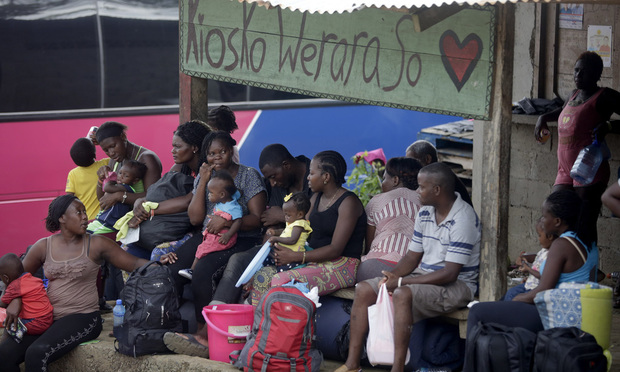Panama Sees Surge in Migrants Crossing Perilous Darien Gap
Panamanian authorities are struggling to contend with a spike in the number of migrants passing through what is known as the Darien Gap, a roadless, lawless region of tropical isthmus that is one of the most dangerous stretches for people heading north from South America.
May 17, 2019 at 10:00 AM
7 minute read
 A group of migrants wait for buses to take them north, in Penitas, Darien province, Panama. (AP Photo/Arnulfo Franco)
A group of migrants wait for buses to take them north, in Penitas, Darien province, Panama. (AP Photo/Arnulfo Franco)
Venise Felizor lay on a mattress in a warehouse-turned-shelter on a hot, sticky afternoon with her 20-month-old son, Wesly, in her arms, the boy coughing and wailing after suffering from diarrhea for days.
Originally from Haiti, they recently appeared in this tiny Panamanian village after a six-day hike through the jungle along the Colombian border, where armed robbers stole her husband's backpack containing the $1,000 that he had saved from two years working in Chile. The thieves raped three women in their group.
“The way was very dangerous,” said Felizor, 26. “I thought my son was going to be lost. I saw scenes of death.”
Panamanian authorities are struggling to contend with a spike in the number of migrants passing through what is known as the Darien Gap, a roadless, lawless region of tropical isthmus that is one of the most dangerous stretches for people heading north from South America, usually toward the United States or Canada.
It's the biggest migratory crisis Panama has faced since 2015-2016, when about 60,000 people crossed the Darien Gap, an exodus that prompted governments to temporarily close borders in Panama, Costa Rica and Nicaragua. According to the National Border Service of Panama, or Senafront, 7,316 migrants came through the Gap this year as of April 18. Such traffic tends to fall off during the imminent rainy season, but the numbers are still on pace to well exceed the 9,678 who made the passage last year and potentially rival 2015-2016.
In interviews, the migrants say they are fleeing poverty, misery, discrimination, political conflicts, war and extremist violence.
“I think what is happening at the Colombian-Panamanian border is a reflection of what is happening on an international level. … It is a search for hope, for opportunities, for well-being, for a vital minimum that is not being provided by the state where they come from,” said Johanna Fernanda Navas, a researcher on migration and human rights at the Catholic University of Colombia.
Most in the surge in Panama are migrants from Haiti or Cuba, with smaller numbers coming from African nations such as Cameroon and Congo, plus the South Asian countries of India, Bangladesh and Sri Lanka.
Cubans have for years flown to Ecuador to begin their journey, though recently many have begun to opt for abbreviated routes beginning in Panama or Nicaragua. Haitians came to South America years ago following their country's disastrous 2010 earthquake, more recently deciding to move on when work dried up.
African and Asian migrants tend to arrive by boat or air in Brazil, crossing the Amazon to Peru and turning north through Ecuador to Colombia, where they hire smugglers to shepherd them through the Gap.
“Our jungle is a bad jungle. … That journey is very dangerous [with] unscrupulous people, 'coyotes,' who guide them through the jungle and abandon them to fate,” said José Samaniego, eastern brigade chief for Senafront in the town of Meteti, one of the last outposts along the Pan-American Highway before it ends on this side of the Darien Gap.
The Gap's perils are numerous. Tales are common of robberies and sexual assault by marauding bands of armed Colombians and Panamanians, and encounters with the drug trafficking “mules” who walk the same paths as the migrants.
“The jungle aspect of it was so terrible because it was the survival of the fittest, you understand?” said Afolabi Ojo, who fled his home in northern Nigeria after the extremist group Boko Haram killed his entire family. “The environment was so deadly. You can imagine somebody coming from the bush, from the forest.”
Darien's rivers can rise suddenly and furiously, and in recent weeks at least 10 migrants were reportedly swept to their deaths. Samaniego said the toll could be higher, but there is no way of knowing given the remote and unforgiving nature of the area.
A Congolese man who gave his name as just Kerlo said a person traveling in his small party drowned.
“We could not even bury him because the current took him away,” the man said through tears, pointing at the river.
The International Organization for Migration's Panama branch says migrants who traverse the Darien jungle often arrive “in very bad shape.” Senafront says the most common maladies are diarrhea, vomiting, skin inflammation, foot mold and dehydration.
Emerging from the Gap, most migrants pass through the hamlets of Bajo Chiquito or Canaan Membrillo before making their way by foot or boat along the Chucunaque River to Penitas.
In normal times, Penitas is an indigenous village with fewer than 200 inhabitants who ply the river in narrow wooden skiffs. They have no running water, cellphone coverage, medical clinic or regular transportation.
These days Penitas is overwhelmed by migrants, who sleep on bunk beds and floor mats in the warehouse or outside in tents. They wash clothes in the muddy waters of the Chucunaque, hang things to dry on clothes lines and chain link fencing and relieve themselves in blue portable toilets set up outside the shelter.
Samaniego estimated on a recent day that there were more than 1,500 migrants at the Penitas camp, which was planned to hold only 100 to 200 and just a few months ago was housing around 80 or 90 on a given day.
Nearly 1,200 more were back in Bajo Chiquito, he said, plus about 1,000 who had been bused to a temporary shelter in Chiriqui, near Panama's western border with Costa Rica. The International Organization for Migrants said Costa Rica is allowing 50 to 100 of the migrants to enter each day.
Samaniego acknowledged that this year's surge took authorities by surprise. After the migration flows of 2015-2016 fell drastically, Panama closed several camps and left only Penitas in operation. Now officials are scrambling to rehabilitate another shelter at Lajas Blancas where migrants would be in better conditions.
At Penitas, officials vaccinate migrants for measles, tetanus and rubella and are doing background checks as a security measure before transporting them west. The International Organization for Migrants said it is working with immigration authorities and border police to better manage the camp, and with the help of others such as the United Nations to provide beds, mattresses and mosquito nets.
The U.N. Refugee Agency's Panama office said it visited the camp in early May to counsel migrants about applying for asylum and mechanisms for people in need of international protection.
Although most of the immigrants hope to get to North America, some said they were applying for refuge in Panama.
One of them was Lisandra Pérez Molina, a 24-year-old from Santa Clara, Cuba. She gave birth April 14 in an indigenous village before arriving in Penitas and a month later was tired of waiting at the crowded shelter.
“What I want is for them to get me out of here,” Pérez said angrily as the boy slept in diapers inside a tent next to his brother Yusnel, 1.
“My boy has rights here, and we as parents have them, too,” Pérez said.
She held up the birth certificate inscribed with her Panama-born son's name: Darién.
Juan Zamorano reports for the Associated Press.
This content has been archived. It is available through our partners, LexisNexis® and Bloomberg Law.
To view this content, please continue to their sites.
Not a Lexis Subscriber?
Subscribe Now
Not a Bloomberg Law Subscriber?
Subscribe Now
NOT FOR REPRINT
© 2025 ALM Global, LLC, All Rights Reserved. Request academic re-use from www.copyright.com. All other uses, submit a request to [email protected]. For more information visit Asset & Logo Licensing.
You Might Like
View All
'Black Box Evidence is Bulletproof': South Florida Attorneys Obtain $1 Million Settlement
2 minute read
University of Florida Drops Title IX Investigation Against Basketball Head Coach
2 minute read
Kirkland & Ellis Taps Former Co-Chair of Greenberg Traurig’s Digital Infrastructure Practice
3 minute read
Trending Stories
- 1Law Firms Report Wide Growth, Successful Billing Rate Increases and Less Merger Interest
- 2CLOs Face Mounting Pressure as Risks Mushroom and Job Duties Expand
- 3X Faces Intense Scrutiny as EU Investigation Races to Conclusion & Looming Court Battle
- 4'Nation Is in Trouble': NY Lawmakers Advance Bill to Set Parameters for Shielding Juror IDs in Criminal Matters
- 5Margolis Edelstein Broadens Leadership With New Co-Managing Partner
Who Got The Work
J. Brugh Lower of Gibbons has entered an appearance for industrial equipment supplier Devco Corporation in a pending trademark infringement lawsuit. The suit, accusing the defendant of selling knock-off Graco products, was filed Dec. 18 in New Jersey District Court by Rivkin Radler on behalf of Graco Inc. and Graco Minnesota. The case, assigned to U.S. District Judge Zahid N. Quraishi, is 3:24-cv-11294, Graco Inc. et al v. Devco Corporation.
Who Got The Work
Rebecca Maller-Stein and Kent A. Yalowitz of Arnold & Porter Kaye Scholer have entered their appearances for Hanaco Venture Capital and its executives, Lior Prosor and David Frankel, in a pending securities lawsuit. The action, filed on Dec. 24 in New York Southern District Court by Zell, Aron & Co. on behalf of Goldeneye Advisors, accuses the defendants of negligently and fraudulently managing the plaintiff's $1 million investment. The case, assigned to U.S. District Judge Vernon S. Broderick, is 1:24-cv-09918, Goldeneye Advisors, LLC v. Hanaco Venture Capital, Ltd. et al.
Who Got The Work
Attorneys from A&O Shearman has stepped in as defense counsel for Toronto-Dominion Bank and other defendants in a pending securities class action. The suit, filed Dec. 11 in New York Southern District Court by Bleichmar Fonti & Auld, accuses the defendants of concealing the bank's 'pervasive' deficiencies in regards to its compliance with the Bank Secrecy Act and the quality of its anti-money laundering controls. The case, assigned to U.S. District Judge Arun Subramanian, is 1:24-cv-09445, Gonzalez v. The Toronto-Dominion Bank et al.
Who Got The Work
Crown Castle International, a Pennsylvania company providing shared communications infrastructure, has turned to Luke D. Wolf of Gordon Rees Scully Mansukhani to fend off a pending breach-of-contract lawsuit. The court action, filed Nov. 25 in Michigan Eastern District Court by Hooper Hathaway PC on behalf of The Town Residences LLC, accuses Crown Castle of failing to transfer approximately $30,000 in utility payments from T-Mobile in breach of a roof-top lease and assignment agreement. The case, assigned to U.S. District Judge Susan K. Declercq, is 2:24-cv-13131, The Town Residences LLC v. T-Mobile US, Inc. et al.
Who Got The Work
Wilfred P. Coronato and Daniel M. Schwartz of McCarter & English have stepped in as defense counsel to Electrolux Home Products Inc. in a pending product liability lawsuit. The court action, filed Nov. 26 in New York Eastern District Court by Poulos Lopiccolo PC and Nagel Rice LLP on behalf of David Stern, alleges that the defendant's refrigerators’ drawers and shelving repeatedly break and fall apart within months after purchase. The case, assigned to U.S. District Judge Joan M. Azrack, is 2:24-cv-08204, Stern v. Electrolux Home Products, Inc.
Featured Firms
Law Offices of Gary Martin Hays & Associates, P.C.
(470) 294-1674
Law Offices of Mark E. Salomone
(857) 444-6468
Smith & Hassler
(713) 739-1250






